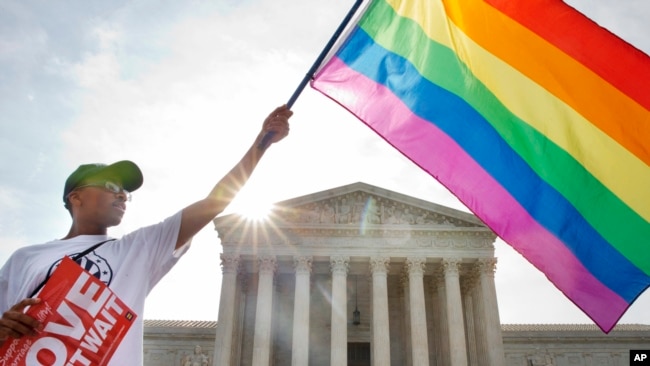アメリカ同性婚に関するレポートより
日本でも国税調査の時期ですが、
この調査では、同性カップルと異性カップルだけでなく、男性カップルと女性カップルの間での経済的な差までが述べられています。
単語も
Same-sex marriages /female couple households /male couple households/same-sex married couples /same-sex married households /opposite-sex households/heterosexual male counterparts/gay,lesbian and bisexual
と多く、さらに世帯数に$、% と盛りだくさん。
私は 聴きながら遂には、図・対比表を書いてしまいました。
数字の嵐の今日のVOAニュース。
Here we go!!
同性愛の結婚が合法化されて以来、米国では70%増
Gay Marriage Up 70% in US Since Legalization
最高裁がそのような関係を合法化してから5年が経過した今、同性婚はアメリカの50万世帯を占めるようになりました。
The U.S. Census Bureau 米国勢調査局は先週、結婚している同性婚世帯の数が2014年から7割近く増加したと報告しました。この数字は、国勢調査局が発表したアメリカン・コミュニティ調査に基づくものです。
同調査によると、国内の約98万世帯が同性カップルに属していることが分かりました。同調査は58%、つまり58万6000人強が既婚者であることを示していました。残りの42%は結婚以外で同棲しています。
女性カップル世帯の方が男性カップル世帯よりも多かったのですが、それほど多いというわけではありませんでした。ゲイリー・ゲイツ氏は、LGBT問題を専門とする人口統計学者です。彼は、「結婚の平等に反対する人たちは、同性カップルは本当に結婚にそれほど興味がないのではないかと、よく主張していました。しかし、全国的に婚姻の平等が法制化されて以来、同性カップルの結婚が大幅に増加していることは、同性カップルの間で結婚に対する明確な欲求があることの証拠となっています」と述べています。
この調査では、同性カップルと異性カップルだけでなく、男性カップルと女性カップルの間でも経済的な差が顕著に見られました。
同性婚カップルは一般的に、より多くのお金を稼いでいることがわかりました、彼らの平均収入は年間約 $10 万 7,000 。異性カップルの額は、およそ $97,000。同性婚の中で、男性カップルは女性カップルよりも多く稼いでいました。 -女性カップルの $87,690に対して男性カップルは $123,646 。
この研究はまた、同性婚世帯が異性婚世帯より働く可能性が高いことがわかりました - 異性婚世帯80.4%に対して同性婚世帯84.6%。
研究では、同性世帯の既婚女性は、異性世帯の既婚女性よりも働いている可能性がはるかに高いことが示されています。しかし、同性世帯の既婚男性は、異性世帯の既婚男性よりも働いている可能性が低かったのです。
ゲイツ氏は、「ゲイとバイセクシャルの男性は、平均して、異性愛の男性よりも多くを稼いでいないという調査がほとんどですが、この調査では、レズビアンとバイセクシャルの女性よりも多くを稼ぐ傾向があることも示されています」と述べています。
木曜日に発表された別の調査結果でも、同性カップルのほぼ15%が18歳未満の子供を少なくとも1人持っていたことを示しています。同じことは、異性のカップルの48%強に当てはまります。
国勢調査局の人口動態調査によると、同性カップルの家庭に住む約30万人の子供のうち、66%が両パートナーの子供であったのに対し、異性カップルの場合は95%でした。
コロンビア特別区は同性カップルの世帯が最も集中していました。首都のコロンビア特別区では、世帯の約2.4%が同性世帯です。近隣のデラウェア州が1.3%でこれに続い、次いでオレゴン州、マサチューセッツ州、ワシントン州が続き、いずれも1%強。
調査では、同性婚世帯の16%以上が異なる人種のカップルで、これは異性婚世帯の2倍の割合です。
米国の2019年の世帯数は1億2200万世帯。国内のゲイ・レズビアンカップルの数は、98万人を超えています、この数字は同性世帯のみを表しています。
2019年のアメリカン・コミュニティ調査では、初めて更新された関係性の識別が含まれており、アメリカの同性世帯の数と質をより良く捉えています。
Gay Marriage Up 70% in US Since Legalization
 Carlos McKnight of Washington, waves a flag in support of gay marriage outside of the Supreme Court in Washington, D.C., June 26, 2015. (AP)
Carlos McKnight of Washington, waves a flag in support of gay marriage outside of the Supreme Court in Washington, D.C., June 26, 2015. (AP)
Same-sex marriages now make up a half a million American households, five years after the Supreme Court legalized such relationships.
The U.S. Census Bureau reported last week that the number of married same-sex households has increased by almost 70 percent since 2014. The numbers are based on the Census Bureau’s American Community Survey.
The survey found that about 980,000 households in the country belong to same-sex couples. It showed 58 percent, or a little more than 586,000, as married. The other 42 percent lived together outside of marriage.
There were more female couple households than male couple households, but not by a lot. Gary Gates, is a demographer specializing in LGBT issues. He said, “Opponents of marriage equality frequently argued that same-sex couples really weren’t all that interested in marriage. But the large increase in marriages among same-sex couples since marriage equality became legal nationwide offers evidence of the clear desire for marriage among same-sex couples.”
The survey showed noticeable economic differences between male couples and female couples, as well as same-sex couples and opposite-sex couples.
The study found that same-sex married couples generally earned more money, with average earnings of about $107,000 a year. That compares to almost $97,000 for opposite-sex couples. Among same-sex marriages, male couples earned more than female couples -- $123,646 compared to $87,690.
The research also found that same-sex married households were more likely to be in the workforce than opposite-sex married households -- 84.6 percent compared to 80.4 percent.
The study showed married women in same-sex households were much more likely to be working than married women in opposite-sex households. But married men in same-sex households were less likely to be working than married men in opposite-sex ones.
Gates said, “While most research that gay and bisexual men, on average, do not earn more than their comparable heterosexual male counterparts, that research also shows that they tend to earn more than lesbian and bisexual women.”
Separate survey results also released Thursday show that almost 15 percent of same-sex couples had at least one child under the age of 18. The same is true of a little more than 48 percent of opposite-sex couples.
Of the nearly 300,000 children living in homes with same-sex couples, 66 percent were children of both partners, compared to 95 percent for opposite-sex couples, reports the Census Bureau’s Current Population Survey.
The District of Columbia had the greatest concentration of same-sex households. In the nation’s capital, about 2.4 percent of households are same-sex households. The nearby state of Delaware followed, with 1.3 percent. The states of Oregon, Massachusetts and Washington came next, all a little over one percent, the survey found.
In the survey, more than 16 percent of same-sex married households were interracial couples, double the rate for opposite-sex married couples.
The U.S. had 122 million households in 2019. The number of gay and lesbian couples in the country is greater than 980,000 since that number only represented same-sex households.
The 2019 American Community Survey for the first time included updated relationship identifications that better captured the number and qualities of same-sex households in the United States.
_________________________________________________
Words in This Story
survey – n. an activity in which many people are asked a question or a series of questions in order to gather information about what most people do or think about something
demographer – n. someone who studies changes, such as the number of births, deaths, marriages, and illnesses, that occur over a period of time in human populations
LGBT – n. short for lesbian, gay, bisexual, transgender and queer
frequently – adj. happening often
heterosexual – adj. sexually attracted to people of the opposite sex
concentration – n. a large amount of something in one place
tend – v. used to describe what often happens or what someone often does or is likely to do